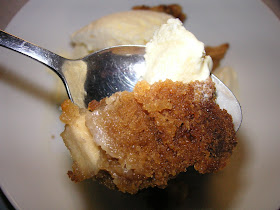
Apple and gingerbread is not a combination I have ever tasted before but as soon as I read this recipe I knew it would work – I could taste the sweet, sticky gingerbread with its kick of heat and the acidity of the apple cutting through it.

The other reason I picked this recipe is because I am a sucker for a cake that’s made in a saucepan – it just feels so wrong! The whole gingerbread is made in one saucepan; how cool is that? I was tempted to try baking it in the saucepan too but realised that the handle meant it wouldn’t fit in any of my air tight containers for storing overnight.

One thing I will say about this, so you don’t panic when you make it, is that the batter is UGLY. I mean ug-ly. It looked most unsavoury – it was lumpy and runny and well, I won’t even describe it the way I want to lest I turn your stomachs.

The CCB (Caked Crusader’s Brother) claimed it was “a perfect winter pud” in a way that made it sound like he was desperate to be quoted. We all mocked him but I’m quoting him anyway because he was right. It’s warming and tasty and comforting.

Ingredients:
125g unsalted butter
125g caster sugar
350g golden syrup
2 eggs
250g plain flour
3 heaped teaspoons ground ginger
1 level teaspoon mixed spice
1 teaspoon bicarbonate of soda
250ml hot water
3 small eating apples, peeled, cored and diced
To serve: custard, ice cream or cream
How to make:
- Preheat oven to 160°C/fan oven 140°C/315°F/ Gas mark 2-3. (Note: if I made this again I would do it on 180°C as, in my oven, this took too long and started to dry the apple out)
- Grease a 2ocm square loose bottom tin and line the base.
- Put the butter, sugar and golden syrup into a saucepan – make sure the saucepan is large enough to hold all the other ingredients. Heat gently until the butter and sugar have melted and you have a smooth, thick mixture. (My tip for weighing out golden syrup, treacle or anything sticky like that is to put the bowl or saucepan on the scales and pour it straight into that, rather than weigh in the scales’ pan and then have to scrape it out into the other bowl).
- Remove the saucepan from the heat and allow to cool slightly.
- While the mixture is cooling weigh out all the dry ingredients i.e. flour, ginger, spice, bicarbonate of soda, and prepare your apples.
- Using a wire whisk, beat the two eggs into the butter mixture.
- Sieve half of the dry ingredients into the butter mixture and stir in.
- Add half of the hot water and stir in.
- Stir in the rest of the dry ingredients, followed by the rest of the water.
- At this point the mixture will be fizzing due to the bicarbonate of soda and it is quite hard to get the wet and dry ingredients to mix. Be gentle and stop stirring as soon as they are combined; over-mixing will make the gingerbread tough.
- Pour the ugly, lumpy batter into the prepared tin and scatter the chopped apples over the top.
- Bake for 1 hour and 15 minutes but check after 1 hour. It is ready when a skewer inserted into the gingerbread comes out cleanly. Mine took 1 hour and 45 minutes and, because of this, the apple started to dry a little on the top – next time I would bake at a higher temperature.
- Leave in the tin and cool completely on a wire rack. This pudding is better if made a day in advance as it becomes fuller flavoured and stickier overnight.
- Cover with foil and reheat in a gentle oven – approximately 160°C/fan oven 140°C/315°F/ Gas mark 2-3 for 20 minutes and serve with custard, cream or ice cream.
- Bask in glory at the wonderful thing you have made.
- Eat.












































